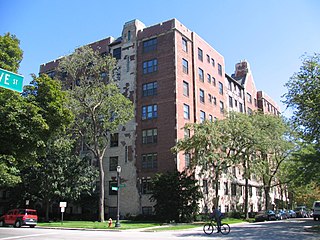
Raymond Park Apartments is a historic apartment building at the northeast corner of Hinman Avenue and Grove Street in Evanston, Illinois. The seven-story building was built in 1928; at the time, it was one of Evanston's largest residential apartments. Architects Hall, Laurence & Ratcliffe designed the building in the Tudor Revival style. The building has a brick exterior with sections of rough stone; the exterior is decorated with half-timbering and leadlight windows. The Tudor style is continued in the building's lobbies, which include strapwork, oak panels, and slate flooring.
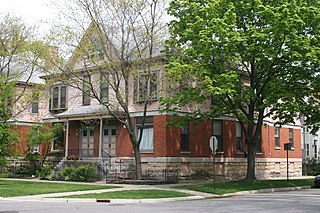
The Buildings at 1301–03 and 1305–07 Judson Avenue are two identical apartment buildings in Evanston, Illinois. Built in 1894, the buildings were among Evanston's first multi-unit apartments. Each building has four units which form a "U" shape. Architect Sidney Smith designed the buildings in the Queen Anne style, which was popular in the late nineteenth century and used in many houses in the vicinity of the apartments. The buildings each feature a brick first floor and shingled second floor, a single porch with two entrances, bay windows, and a bracketed cornice.

Castle Tower Apartments is a historic apartment building at 2212-2226 Sherman Avenue in Evanston, Illinois. The three-story building was built in 1928. The building has a "U" shape, a common form for apartment buildings in Evanston, with a large courtyard in the middle. Architects Cable & Spitz designed the building in the Tudor Revival style. Their design includes several rounded and square towers along the sides of the building, crenellation on the towers and roofline, sections of half-timbering, and patches of limestone on the otherwise brick exterior.
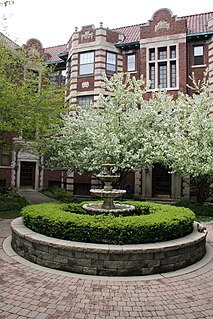
Fountain Plaza Apartments is a historic apartment building at 830-856 Hinman Avenue in Evanston, Illinois. The three-story brick building was built in 1922. Architect John Nyden, who also designed multiple other apartment buildings in Evanston, designed the building in the Classical Revival style. The building's design includes Palladian doors with fanlights, limestone quoins, and a hip roof with parapets and a cornice. The central courtyard is both raised and nearly surrounded by the building, providing privacy despite the building's proximity to a commercial district.

Hinman Apartments is a historic apartment building at 1629-1631 Hinman Avenue in Evanston, Illinois. Built in 1904, the three-story brick building has six apartments. Architects Atchison & Edbrooke, who also designed Evanston's Ridgewood Apartments, designed the building in the Classical Revival style. The building's design includes a two-story portico supported by Ionic columns, bow windows on either side of the portico, and a dentillated cornice and parapet. The apartments are arranged in a railroad plan, with rooms arranged along a long central hallway; while this layout was often associated with cheap apartments, the Hinman still targeted upper-class residents with its design and amenities.

Lake Shore Apartments is a historic apartment building at 470-498 Sheridan Road in Evanston, Illinois. The three-story building was built in 1927. Its location was chosen to provide views of Lake Michigan and relative distance from Evanston's busier commercial areas; to compensate for this, the owners provided residents with transportation to local schools and public transit stations. Architect Roy F. France, who also designed several other Evanston apartment buildings, designed the building in the Georgian Revival style. The building features a brick exterior with terra cotta detailing, projecting bays and bow windows, and an arcade leading to a private courtyard.
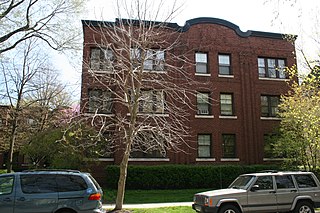
Maple Court Apartments is a historic apartment building at 1115-1133 Maple Avenue in Evanston, Illinois. The three-story brick building was built in 1915. Architect George S. Kingsley gave the building a geometrical design similar to those used in Prairie School buildings, though the building is not itself Prairie School. The building's design includes patterned brickwork, limestone arches and windowsills, and parapets with decorative sunbursts. The U-shaped building surrounds an open courtyard, a common feature of Evanston's apartment buildings.

Michigan-Lee Apartments is a historic apartment building at 940-950 Michigan Avenue in Evanston, Illinois. The three-story brick building was built in 1928. Architect Frank W. Cauley, who also designed Evanston's Orrington Hotel, designed the building in the Georgian Revival style. The building features entrances flanked by columns, limestone quoins, and a parapet with decorative urns. A sunken courtyard occupies the center of the building; while courtyards were common in Evanston's apartments, the sunken design is unusual within the city.

Oakton Gables is a historic apartment building at the southeast corner of Oakton Street and Ridge Avenue in Evanston, Illinois. The three-story brick building was built in 1927. Architect Godfrey E. Larson designed the Tudor Revival building. The building's design includes limestone trim and window hoods, a raised central courtyard, and gables projecting above the roofline, some of which are half-timbered. The design's use of copper is particularly distinctive; the courtyard entrance has copper-clad towers on either side, and it is also used for downspouts and flashing.
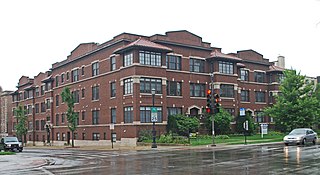
Ridge Boulevard Apartments is a historic apartment building at the southeast corner of Ridge Avenue and Main Street in Evanston, Illinois. The three-story brick building was built in 1913. Owner Thomas McCall, who was also an architect, designed the building. McCall's design included miter arched entrances, bay windows, stone banding, and a rear courtyard. The twenty-one apartments in the building featured amenities such as sun porches, servants' rooms, and fireplaces in the larger units.

Ridge Grove is a historic apartment building at 1112 Grove Street in Evanston, Illinois. The three-story brick building was built in 1928. Architect Edward M. Sieja designed the building, which incorporates geometric and Neoclassical elements. The building features a projecting section across most of its front facade, sidelights and a fan around the entrance, limestone trim, and piers at its corners. The lobby includes a mock fireplace to resemble the foyer of a house.
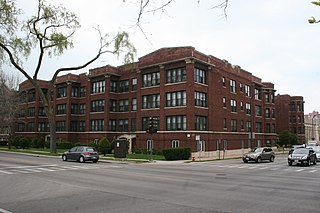
Ridge Manor is a historic apartment building at the northeast corner of Ridge Avenue and Davis Street in Evanston, Illinois. The three-story brick building was built in 1916. The building consists of two sections; the section facing Ridge Avenue contains the building's larger apartments, while the U-shaped section facing Davis Street contains smaller apartments and includes an open courtyard. Architect William H. Pruyn, Jr., designed the building. The building's design features limestone detailing, protruding bays, and a cornice and parapet at the roof line.

Rookwood Apartments is a historic apartment building at 718-734 Noyes Street in Evanston, Illinois. The three-story brick building was built in 1927. Architects Conner & O'Connor designed the building in the Tudor Revival style. The building's design includes limestone trim, large square blocks of stone separating the casement windows, and ashlar stone entrances and courtyard walls. The building is noteworthy among Evanston's apartments for its two courtyards; one is open and faces the street, while the second is more private and to the side of the building.
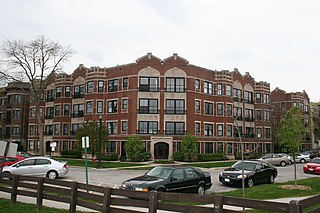
Sheridan Square Apartments is a historic apartment building at 620-638 Sheridan Square in Evanston, Illinois. The three-story brick building was built in 1924. The building has an S-shaped layout which wraps around a corner and features an open courtyard. Architect Anthony Quitsow designed the building in the Tudor Revival style. The building's design features Gothic arched entrances, French windows with limestone spandrels, limestone banding near the roof, and several double gables facing the street.

The Building at 1505–1509 Oak Avenue is a historic apartment building in Evanston, Illinois. The three-story brick building was built in 1925. The building is L-shaped with a half courtyard, a relatively common apartment layout in Evanston. Architect Samuel N. Crowen, who designed two other apartment buildings in Evanston, designed the building. The building's design features limestone pilasters separating its windows, limestone quoins, pilasters and a pediment around the entrance, and a brick parapet.

The Building at 1929–1931 Sherman Avenue is a historic apartment building in Evanston, Illinois. The three-story brick building was built in 1928. The building has an L-shaped layout with a half courtyard, a relatively common layout for Evanston's apartments. Architects Maher and McGrew, who designed several other buildings in Evanston, designed the building in the Tudor Revival style. The building's design features large sections of rough limestone on the basement level, limestone quoins, segmental arched windows, half-timbering, and a series of gables and dormers at the roof line.

The Building at 417–419 Lee Street is a historic apartment building in Evanston, Illinois. The two-story four-flat building was built in 1902. Architect Edgar O. Blake, an Evanston architect who had designed houses in the city since the 1870s, designed the building. The building's design includes a Georgian entrance with side columns, sidelights, and a fanlight, limestone banding, a wooden entablature, and a brick parapet. The four apartments are an early example of upper-class apartment design in Evanston; of particular note are its screened porches, which were a precursor to the sunrooms commonly seen in later buildings.

The Building at 813–815 Forest Avenue is a historic apartment building in Evanston, Illinois. The three-story brick building was built in 1929. The building has an L-shaped layout with a half courtyard, a relatively common pattern among Evanston's apartments. Architect Jens J. Jensen designed the building in the Tudor Revival style, a popular choice for the time. The building's design includes Tudor arched entrances, lancet windows, projecting bays, and a crenellated tower.

The Building at 923–925 Michigan Avenue is a historic apartment building in Evanston, Illinois. The three-story brick building was built in 1916. Architect Robert De Golyer, who designed several apartment buildings in Evanston and Chicago, designed the building; he also moved into the building once it was complete. The building's design features bow windows, pilasters and a fanlight around the entrance, and a dentillated cornice. Each of the building's six apartments included living rooms with fireplaces, sun porches, maid's rooms, vacuum systems, and access to heated garages.
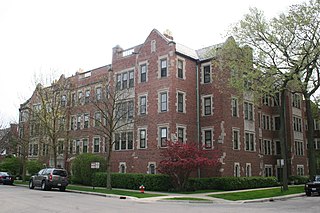
The Building at 999 Michigan, 200 Lee is a historic apartment building at the southeast corner of Michigan Avenue and Lee Street in Evanston, Illinois. The three-story brick building was built in 1927. Architects McNally and Quinn designed the Tudor Revival building. The building's design features arched entrances, projecting bays, limestone window moldings, decorative gargoyles, and a parapet with several gables. The Tudor design continues in the building's interior, which includes wood panels in its lobby, wrought iron balustrades on its staircases, and marble fireplaces in the apartments themselves.























